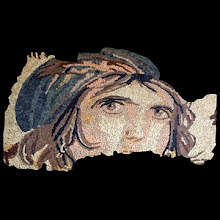
The Art Nouveau movement also embraced mosaic art. In Barcelona, Antoni Gaudi worked with Josep Maria Jujol to produce the stunning ceramic mosaics of the Guell Park (below) in the first two decades of the 20th century. These used a technique known as trencadis in which tiles (purpose-made and waste tiles) covered surfaces of buildings. They also incorporated broken crockery and other found objects, a revolutionary idea in formal art and architecture.
Found objects have been used as mosaic materials in a range of ways, for example in Victorian shell grottoes and "putty pots", where china and other items (buttons, toy figures etc) are stuck to a base with linseed putty. This kind of collage of personal objects with connections to everyday life is also sometimes called "memoryware".
A very influential site has been La Maison Picassiette (in Chartres, northern France), the idiosyncratic work of Raymonde Isidore between 1938 and 1964. As a middle-aged manual worker, he covered his entire house and garden with intricate mosaics of broken crockery. His nickname ("Picassiette") came from a French expression meaning a "scrounger": This expression - "pique assiette" - is the name given today to this very popular style of mosaic.

No comments:
Post a Comment